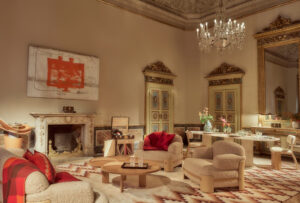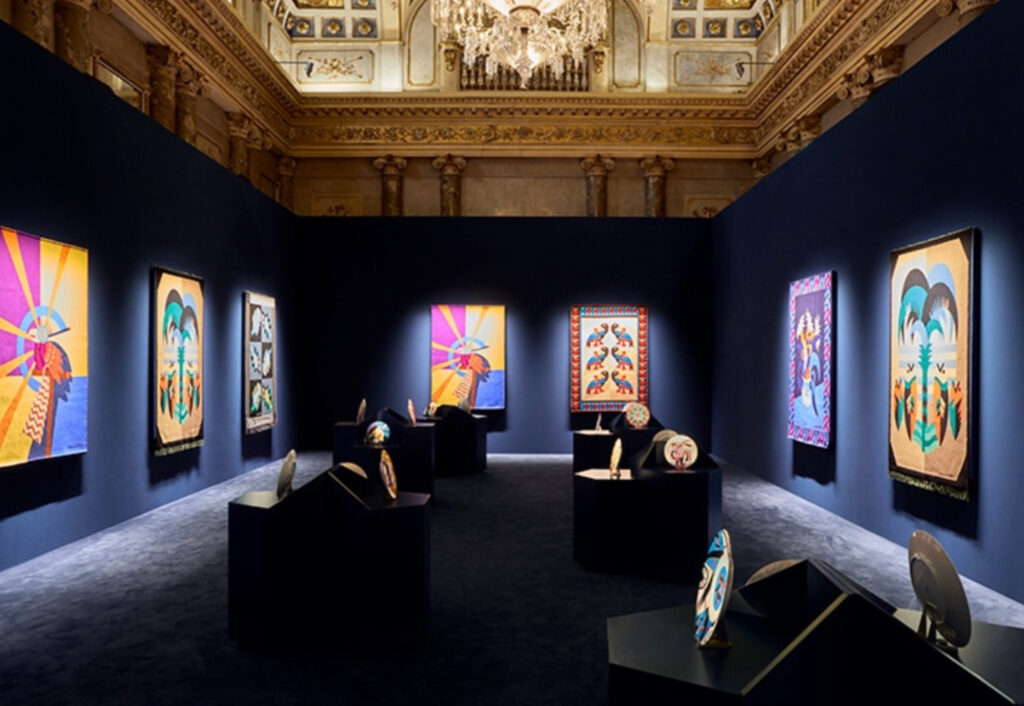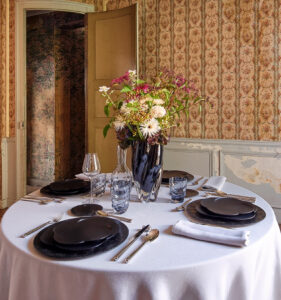
At Milan Design Week 2025, Louis Vuitton took a bold leap from high fashion into high interiors. Hosted within the ornate walls of Palazzo Serbelloni—a neoclassical masterpiece nestled in the midst of Milan—the House unveiled its most immersive, multidimensional presentation of furniture and home objects to date. More than just a continuation of its decade-long Objets Nomades series, this year’s installation marked the birth of the Louis Vuitton Home Collection, a permanent foray into the realm of interior design. With its mix of innovation, craftsmanship, and nomadic soul, the exhibition married French haute with the poetry of everyday living.
From Travel Objects to Everyday Living
Louis Vuitton’s relationship with design has always been rooted in travel. From steamer trunks to custom cases for watches, tea sets, or DJ gear, the brand has extended its identity well beyond garments and leather goods. The Objets Nomades collection, first introduced in 2012, channeled this spirit through limited-edition furniture crafted in union with world-renowned designers like India Mahdavi, Patricia Urquiola, Raw Edges, and the late Humberto and Fernando Campana. These creations, however, were primarily collectibles—artful and ephemeral pieces that blurred the line between design and sculpture.
Now, in 2025, Louis Vuitton takes that ethos further with the Home Collection. Conceived as a seamless extension of Objets Nomades, this new line introduces a deeper, more integrated vision of domestic life. Not merely decorative or symbolic, these pieces are designed for use—for living. Chairs meant to be sat on, cabinets to be opened, textiles to be wrapped in. The spirit of travel remains, but now it brings comfort home.
Palazzo Serbelloni: The Staging of Elegance
Choosing Palazzo Serbelloni as the venue was no accident. The palace, with its classical façade, frescoed ceilings, and golden moldings, offered the perfect counterpoint to the contemporary, almost experimental nature of Louis Vuitton’s designs. It created a dialogue between the opulent past and a fluid, forward-thinking present.
Each room of the palazzo was transformed into a living diorama—part showroom, part narrative tableau. Visitors didn’t merely walk past objects on pedestals. They entered spaces that breathed with mood and character. It was an experience akin to walking into a home where every element told a story—not just of design, but of heritage, imagination, and craftsmanship.
Signature Pieces: Where Function Meets Craft
Central to this new venture is the Signature collection, developed by French designer Patrick Jouin and Argentinian designer Cristián Mohaded. Known for their sculptural sensibility and refined sense of materials, the duo delivered a suite of furniture that is unmistakably Louis Vuitton.
The Signature Chair, for instance, takes the Maison’s iconic curves—echoing handles, belts, and monogram flowers—and reimagines them in wood, leather, and hand-polished brass. The use of marquetry (the intricate art of inlaying materials to create pattern) recalled the House’s dedication to artisanal luxury, but this time in the form of tables, cabinets, and even lighting fixtures. These pieces did not scream “designer object.” Instead, they whispered quality and consideration—a slow luxury for those who appreciate detail over ostentation.
What distinguished the Signature series was its livability. This wasn’t conceptual design for collectors; it was everyday luxury. A table to dine on, a lounge chair to sink into, and lamps that illuminated with the warmth of handcrafted intent.
The Parini Room: A Textile Symphony
One of the most celebrated installations within Palazzo Serbelloni was the Parini Room, devoted entirely to textiles. Here, the concept of layering—so familiar in fashion—found new meaning in interior design. Walls, floors, and even ceilings were swathed in woven patterns, silk jacquards, and upholstery velvets.
The room spotlighted a stunning flow of artistic voices: legendary architect-designer Charlotte Perriand, known for her modernist touch; Zanellato/Bortotto, the Italian duo specializing in weaving heritage into contemporary design; Cristián Mohaded, again showing his multifaceted talents; and a jovial surprise—Fortunato Depero, the Italian Futurist whose work in graphic design and color theory inspired vibrant, almost childlike patterns.
An especially striking inclusion was the Malle Vin, a reinterpretation of the classic Louis Vuitton trunk. This version held not Champagne flutes or makeup compartments, but bolts of fabric and artisanal tools, repurposed for the textile craftsman.
Sculptural Play: Estúdio Campana’s Imaginative Vision
Estúdio Campana, long-time collaborators of Objets Nomades, brought a welcome sense of surrealism to the installation. Their Kaleidoscope Cabinet was part furniture, part sculpture, and entirely dreamlike. Crafted from layers of multi-colored wood and leather, its reflective doors opened to reveal shifting geometric interiors—a metaphor, perhaps, for the inner world of the traveler.
Nearby, their modular game table blurred the line between utility and fantasy. Equal parts chessboard and art piece, it invited not just play, but participation—a reminder that luxury can also be light-hearted.
The Campanas’ contribution underscored a central theme of the exhibition: the integration of narrative and function. These weren’t just objects; they were provocations, inviting us to reimagine the rituals of living.
The Beauharnais Room: A Living Space Realized
In the Beauharnais Room, Louis Vuitton made its clearest case for domestic immersion. Unlike the more abstract or theatrical spaces elsewhere, this room was designed like a real apartment—complete with living, lounging, and reading zones. Yet it maintained the aesthetic rigor expected from the brand.
The centerpiece was the Lagoon Sofa by Patrick Jouin, a curved, low-slung masterpiece that embraced the body like a quiet tide. Upholstered in soft suede and punctuated with monogrammed buttons, it was equal parts sculpture and refuge.
Paired with it were Patricia Urquiola’s Pecora Armchairs, which borrowed their forms from sheep—round, plush, protective. The Vertigo Coffee Table, with its off-kilter base and mirrored top, reflected the room and its inhabitants, subtly reinforcing the themes of distortion and reflection.
Smaller accents played an equally vital role. The Diago Vases—organic, almost coral-like in their form—and Pétalo Baskets, woven from natural fibers and LV leather, brought texture and breathability to the space. These were not grand statements, but quiet touches that made the house feel like a home.
Depero’s Legacy: Graphic Play and Color Saturation
A separate space was dedicated to Fortunato Depero’s legacy, pushing the boundaries of what we expect from home design. Bright colors dominated—neon reds, cobalt blues, and acid greens—turning fabrics, ceramics, and even plates into wall-hung art. This wasn’t design as backdrop; it was design as protagonist.
Here, function took a backseat to visual dynamism. Plates were meant to be looked at, not used. Rugs climbed the walls. Cushions became totems. In many ways, this room best captured the essence of Louis Vuitton’s identity: an embrace of artistry, movement, and performance.
Artisanal Excellence and French Know-How
Beneath all the conceptual play and immersive design was a deep commitment to traditional craftsmanship. Louis Vuitton collaborated with workshops across Italy and France, some of which specialize in wood bending, leather tanning, marquetry, and weaving. These techniques, honed over centuries, were placed in dialogue with the most contemporary of forms.
Each piece—whether a chaise longue or a decorative vase—came with its own narrative of materials and hands. The Maison’s decision to highlight these processes wasn’t just aesthetic; it was ethical. In a world of mass production, Louis Vuitton reinforced the value of the artisanal and the unique.
From Collection to Cultivation: A Permanent Shift
What’s striking about the Home Collection is that it’s not a seasonal capsule or an experimental pop-up. This marks Louis Vuitton’s entrance into the world of permanent home design, positioning itself not only among heritage fashion houses but alongside historical design ateliers. The shift isn’t just about expanding revenue streams—it’s about cultural presence.
Much like Hermès or Bottega Veneta, who have long invested in furniture and objects, Louis Vuitton is asserting that opulence is no longer confined to the body. It surrounds us—in our homes, in our rituals, and in the objects we choose to live with. This isn’t a collection. It’s a lifestyle proposition.
A Vision of Domestic Poetry
Milan Design Week 2025 will be remembered for many things: bold architecture, AI-generated spaces, sustainable materials. But Louis Vuitton’s intervention at Palazzo Serbelloni will stand apart for its restraint, elegance, and radical softness. It didn’t attempt to revolutionize design with tech gimmicks or dystopian narratives. Instead, it asked a quieter question: What if bespoke was about care? What if design wasn’t disruptive, but poetic?
With the Home Collection, Louis Vuitton has extended its horizon without losing its soul. It has shown that the journey need not always be outward—sometimes, the most profound adventures begin at home.
No comments yet.









